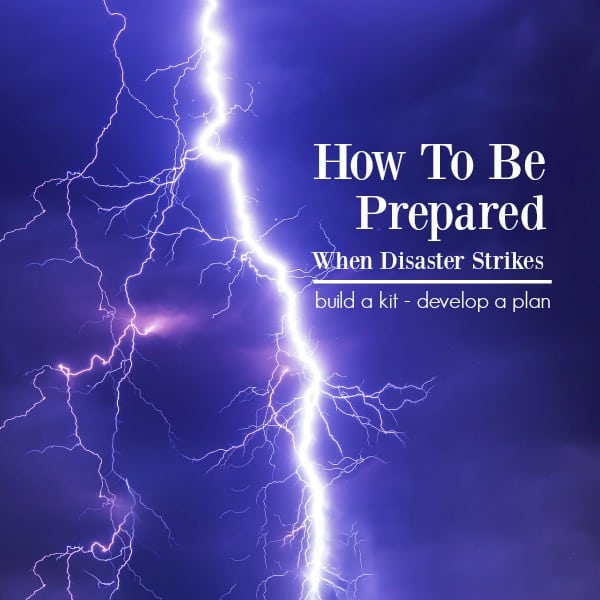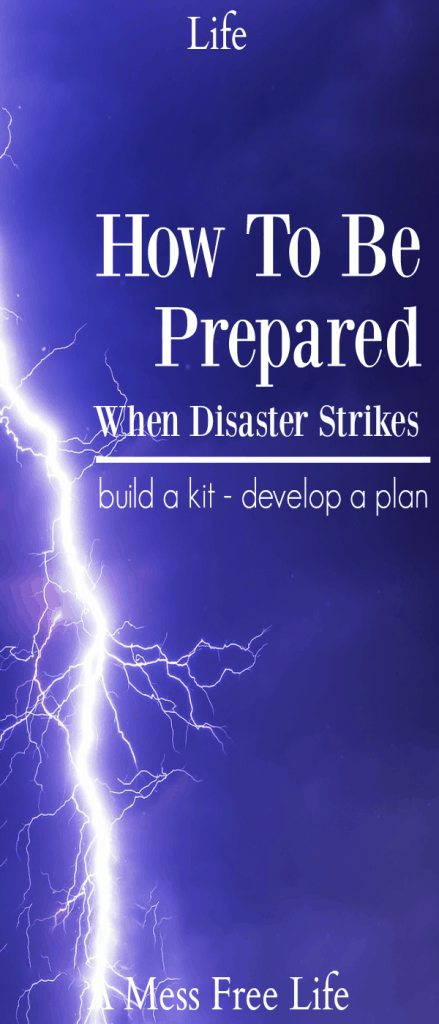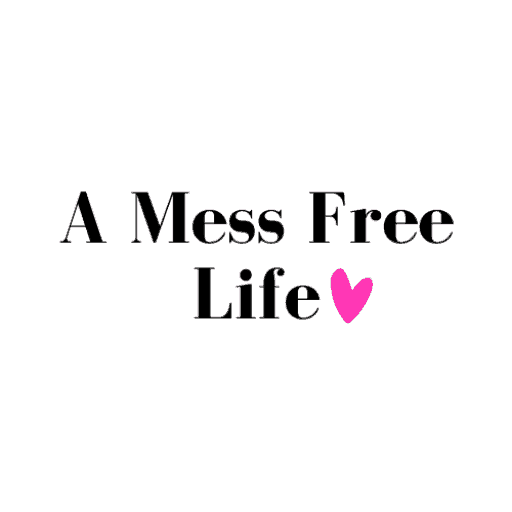A Mess Free Life may collect a share of sales or other compensation from the links on this page.
When disaster strikes knowing you have what you need to keep your family safe, fed and hydrated can give you real peace of mind.
Many people have the attitude that disasters strike other people.
But we’ve been shown time and time again, that’s simply not the case.
Natural or man-made disasters can strike anytime, anywhere.
We’ve recently witnessed the devastating torrential rains that hit the Houston area of Texas, and as I write this Puerto Rico and Florida are bracing for Hurricane Irma to make its way and unleash her wrath.
So, how many people will be prepared?
Not many is my guess and here’s why.
Most people are simply indifferent about disaster preparedness or are simply unaware.
In most cases, amid their chaotic lives, many people have missed the preparedness memo, if there was one. People don’t pay attention until a disaster hits. They don’t think it’s going to happen to them. It’s like telling someone to put a smoke detector in their home. They might do it but then forget about the batteries.
In a survey conducted last year by Columbia Univeristy they uncovered the following findings:
- Nearly two thirds (65 percent) of American households do not have adequate plans and supplies for a disaster. This is virtually unchanged from 2011 (66 percent) and represents only a modest improvement from since 2003 (77 percent).
- 41 percent are not confident that their community has adequate plans in place for a disaster that occurs with no warning, a slight improvement from 2011.
- 51 percent are not confident in the ability of government to meet the needs of children in a disaster and 37 percent are not confident in their community’s ability to meet the needs of children.
- 35 percent of households with children are not familiar with their schools’ evacuation and emergency plans, and 41 percent do not know to what location their children would be evacuated.
But despite the apathy, disasters will come and it’s prudent to be prepared. Here’s how to make that happen in your home.
Table of Contents
HOW TO BE PREPARED WHEN DISASTER STRIKES
BUILD A KIT
Your disaster kit is simply a collection of basic items your household may need in the event of an emergency.
Try to assemble your kit well in advance of an emergency. You may have to evacuate at a moment’s notice and take essentials with you. You will probably not have time to search for the supplies you need or shop for them.
You may need to survive on your own after an emergency. This means having your own food, and water in sufficient quantity to last for at least three days. Local officials and relief workers will be on the scene after a disaster, but they cannot reach everyone immediately. You could get help in hours or it might take days.
Additionally, essential services such as electricity, gas, water, sewage treatment, and telephones may be cut off for days or even a week, or longer. Your supplies kit should contain items to help you manage during these outages.
Related: Food Storage Survival Tips
WHAT TO INCLUDE IN YOUR THREE DAY KIT
Food and Water
(A three-day supply of food and water, per person, when no refrigeration or cooking is available)
-
- Protein/Granola Bars
- Trail Mix/Dried Fruit
- Crackers/Cereals (for munching)
- Canned Tuna, Beans, Turkey, Beef, Vienna Sausages, etc
- Canned Juice
- Candy/Gum
- Water (1 Gallon/4 Liters Per Person)
Related: Food Storage
Bedding and Clothing
-
-
- Change of Clothing (short and long-sleeved shirts, pants, jackets, socks, etc.)
- Undergarments
- Rain Coat/Poncho
- Cloth Sheet
- Plastic Sheet
- Blankets and Emergency Heat Blanks (that keep in warmth). I own these and recommend them. Keep them in your home when the heat goes out and in your car if you’re ever stranded.
-
Fuel and Light
-
-
- Battery Lighting (Flashlights, Lamps, etc.) Don’t forget batteries!
- Extra Batteries
- Flares
- Candles
- Lighter
- Water-Proof Matches or Fire Starter Kit. I own both of these. For the money, it was worth it to me to own both.
-
Equipment
-
-
- Can Opener
- Dishes/Utensils
- Shovel
- Radio (with batteries!)
- Pen and Paper
- Axe
- Pocket Knife
- Rope
- Duct Tape
-
Personal Supplies and Medication
-
-
- First Aid Kit and Supplies
- Toiletries (roll of toilet paper- remove the center tube to flatten easily into a zip-lock bag, feminine hygiene, folding brush, etc.)
- Cleaning Supplies (mini hand sanitizer, soap, shampoo, dish soap, etc.)
- Medication (Acetaminophen, Ibuprofen, children’s medication, etc.)
- Prescription Medication (for three days)
-
Personal Documents and Money
(Place these items in a waterproof container!)
-
-
- Legal Documents (Birth/Marriage Certificates, Wills, Passports, Contracts, etc.)
- Vaccination Papers
- Insurance Policies
- Cash
- Credit Card
- Pre-Paid Phone Cards
-
Miscellaneous
-
-
- Bag(s) to put 72 Hour Kit items in (backpacks work great.) Make sure you can lift/carry it!
- Infant Needs/Elder Needs/Disable Persons Needs (if applicable)
- Cell Phone and Charger
-
Related: Water Storage
Notes:
-
-
- Update your 72 Hour Kit every six months. Put a note in your planner to remind you to check that: all food, water, and medication is fresh and has not expired; clothing fits; personal documents and credit cards are up to date; and batteries are charged.
- Small toys/games are important too as they will provide some comfort and entertainment during a stressful time.
- Have older children be responsible for their 3 day kit.
- You can include any other items in your 72 Hour Kit that you feel are necessary for your family’s survival.
- Some items and flavors might leak, melt, “flavor” other items, or break open. Dividing groups of items into individual Ziploc bags might help prevent this.
-
Most of what is on this list will be easy to assemble.
Prepackaged Kits are also available.
CONCLUSION
Don’t put your head in the sand and think it will never happen to you. Time and time again people are proven wrong. Start planning now and each month add to your kit. Eventually, your kit will be fully stocked and ready for you in the case of an emergency.



